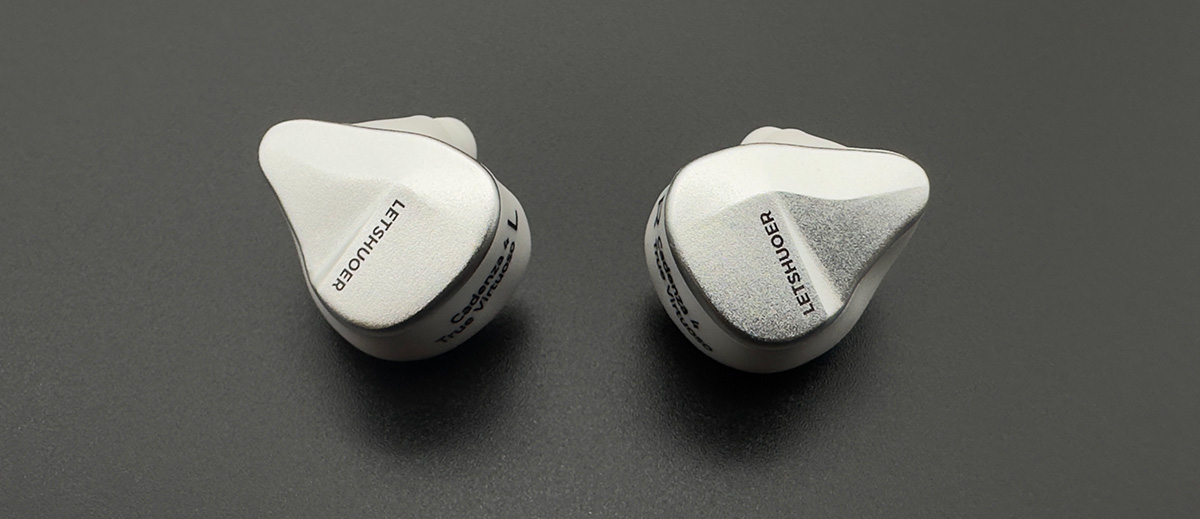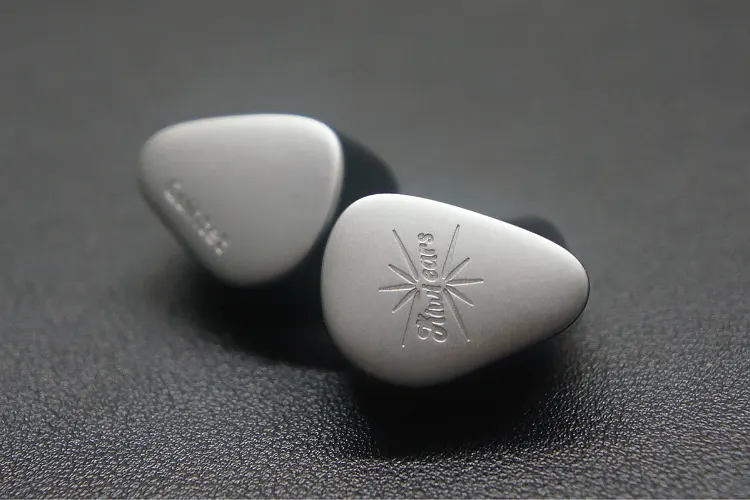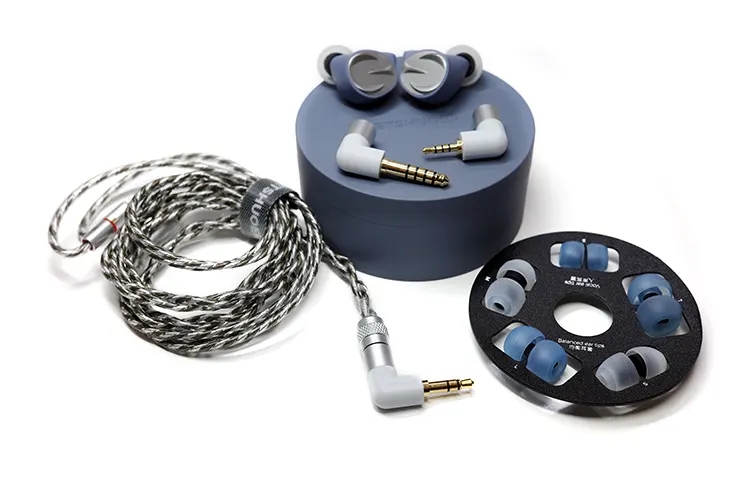Synergy
The Cadenza4 has an impedance of 15Ω @1kHz and a sensitivity rating of 102 dB/Vrms. It’s easy to drive the IEM. It can be easily paired with dongles and smartphones, too.
However, the IEM does benefit from better sources. The IEM has good synergy with a warm neutral source, as a brighter source can induce some sharpness and peakiness in upper frequencies.
On the Lotoo Paw Gold Touch, the bass response is quite good. The lower mids sound fuller and have a decent body. The Cadenza4 takes a few extra volume clicks than usual on the dap.
With the Earmen Angel, an even more powerful source, the Cadenza4 opens up a bit. There is an addition of airiness in the sound too. There is no static hiss in the background with the Angel.
Using a clean and punchy amplifier with decent power output can significantly enhance the Cadenza4’s bass performance and tightness. The dynamics are improved with additional power.
Select Comparisons
Kinera Freya 2.0
Technical
The Kinera Freya 2.0 is a quad-driver hybrid universal IEM rated at 25Ω impedance and 105 dB @1kHz mW SPL.
The driver configuration is three Knowles drivers for the mids and highs and a custom 7mm dynamic driver for the lows with a 3 acoustic tube 3+1 crossover tuning. Both of these IEMs are easy to drive; however, the Cadenza4 can take some extra volume clicks.
Design
The Freya 2.0 shells are made from high-quality resin and are hand-painted. The design of Cadenza4 shells is quite different from that of Freya 2.0. The size of the shells in both of these IEMs is small, and they both fit quite well.
Similarly to the Cadenza4, the Freya 2.0 comes with a modular cable but misses the 2.5mm termination. Otherwise, the quality of the cable is nearly the same.
Kinera offers a more pleasant, colorful presentation, evident in its packaging and designs of the shells.
Performance
The Freya 2.0 has a lean sound profile with a bass performance more on the neutral side. The sub-bass misses the impact, and the midbass does not have a good quantity as well.
Cadenza4 has a better bass profile and benefits a lot from the deeper and better sub-bass. The bass response of the Cadenza4 is fast and has a good extension to it against the mellow bass of the Freya 2.0.
The mids on Cadenza4 are more natural and have better clarity, whereas the Freya 2.0 has an average mids resolution and feels a bit hazy in its presentation.
The treble response on Freya 2.0 is darker than on Cadenza4. The latter has more energy in the upper frequency and sounds airier too. The detailing and clarity in the treble region are a lot better on Cadenza4.
In terms of technical aspects, Cadenza4 is quite ahead, with better soundstage and imaging. The sound on Cadenza is more open and there is better detail retrieval too.
Kiwi Ears Quintet
Technical
The Kiwi Ears Quintet makes use of a 5-driver configuration: a 10mm diamond-like carbon (DLC) dynamic driver, two Knowles balanced armature (BA) drivers, a micro planar magnetic driver (MPT), and a piezoelectric (PZT) bone conductor driver.
It has an impedance of 32Ω and a sensitivity of 108 dB at 1kHz/Vrms which makes it an efficient IEM even with low power input.
Design
The Quintet makes use of a 3D-printed resin shell with a separated metal face plate. The size of the nozzle is similar on both of these IEMs. The build on the Cadenza4 feels better to me.
The shells of Quintet have a small size and are quite lightweight. The weight and size of both the IEMs are comparable, with Quintet having larger shells. Owing to its small size and weight, the Quintet has a very decent fit and can be put on for a very long time without any fatigue.
The stock cable of the Quintet is a 4-core oxygen-free silver-plated copper cable with a 3.5mm single-ended plug and a standard 0.78mm 2-pin connector.
The cable on both of these IEMs is of decent quality, but the inclusion of modular cable on the Cadenza4 makes it a lot more useful.
Performance
In the bass department, I find both of these IEMs performing nearly the same. The mid-bass on the Quintet has more quantity, while the sub-bass has a similar quantity and has a bit more presence on the Quintet.
The bass has good layering and decent texture on the Quintet whereas the bass on the Cadenza has a near-neutral character.
In the midrange, the resolution on both of these IEMs is quite good and comparable. The lower mids on the Quintet have more weight and are more bodied than those on the Cadenza.
The upper mids on the Quintet are occasionally sharp and have unwanted peakiness, which the Cadenza4 does not have.
In the treble region, the Quintet has an edge and can sound airier than the Cadenza4. The piezo driver does the job well for the treble presence with more energy and a better extension. For treble-sensitive people, the Cadenza4 is a better option.
In terms of technical aspects, both of these IEMs are very solid. The imaging is better on the Cadenza4, and the soundstage has a nearly similar width. Timbre-wise, my preference goes for the Cadenza4, as it sounds more natural and has a controlled treble.
LETSHUOER S15
Technical
The S15 is a 3rd generation 14.8mm planar driver universal IEM from LETSHUOER. It adds a proprietary 6mm R-Sonic filter inside to further enhance the tuning. This is the brand’s last release before the Cadenza4.
The S15 is rated at 30Ω with a sensitivity of 106 dB @1 kHz mW, making it an easy-to-drive IEM. It can also take a good amount of power, and sound does improve with a better source and amping.
Design
One of the reasons to put the S15 for comparison against the Cadenza4 is how similarly these IEMs have been designed. Right from the unboxing experience to the way the IEM shells have been built, there are a lot of similarities.
Both of these IEMs have been built with resin and have similar shiny faceplates. The finish on both IEM shells is matte. Both of these IEMs have smaller shells that are relatively lightweight and fit well in the ear.
The cables on both the S15 and the Cadenza4 have a similar design. The cable on S15 is thicker and has a firmer character with a mix of silver and black colored finishing. Both are modular designs and have similar-shaped plugs.
Performance
The bass on the S15 is punchier and has a good quantity, whereas the Cadenza4 lacks a bit. This bass makes the S15 a lot more enjoyable. The bass does not get bloaty or boomy. It has a nice decay, and the texture and layering are also decent. This bass is more mature on S15.
In the midrange, the S15 has an edge and a thick and lush character. The lower midrange has a good body, while the upper mids are thinner in comparison. The vocals have a good texture. The midrange instruments have plenty of weight and richness in their sound.
In the upper frequency, the Cadenza4 has more energy and detailing. The presence of air and sparkle is not quite pronounced on the S15. There is a lack of energy with more of a relaxed signature without any sharpness.
In terms of technical capabilities, the S15 fairs well and is ahead of the Cadenza4. The layering and imaging on the S15 are decent and the soundstage feels more spacious than the Cadenza4.
In terms of timbre, the S15 is a lot better than most planar IEMs in the market. The metallic timbre, which planars are notorious for, is almost negligible here.
Our Verdict
The LETSHUOER Cadenza4 proves to be a pleasantly refreshing IEM. Despite its seemingly standard driver configuration, the tuning is impressive. This sound signature particularly will appeal to those with a preference for a tonally accurate, neutral coloration.
While the bass lacks a bit of punch, it exhibits good quality with a decent sub-bass presence. The midrange is notably sweet, and the IEM showcases impressive technical performance.
With its nice build, attractive aesthetics, and comprehensive set of accessories, the Cadenza4 emerges as a commendable release from LETSHOUER.
LETSHUOER Cadenza4 Specifications
- Driver: 10 mm beryllium-coated dynamic driver + 3 BA drivers (1 Sonion and 2 Knowles BA drivers)
- Frequency response range: 20-40 kHz
- Impedance: 15 Ω
- Sensitivity: 102 dB
- Cable: Silver-plated monocrystalline copper cable (1.2m length)
- Connector Type: 0.78mm 2-pin
- Termination Plug: Modular plugs with 2.5 mm, 3.5mm, and 4.4 mm termination
- IEM body material: 3D-printed resin





